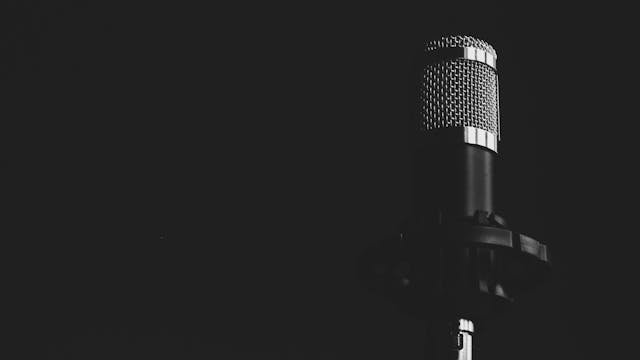Last Updated on March 13, 2024 by Nasir Hanif
In an environment where everything is happening rapidly, the quality of sound systems has also been developed and become more advanced. Microphones that play an important role in the vocal sound system, can now produce sounds from multiple directions. However, it is possible for a listener to hear the sounds from different surrounding areas. In this article, you will get to know everything about Omnidirectional Microphones and their use. To choose the best microphone, Microphone Globe website is the best place that helps you to choose the right one.
Omnidirectional microphones take the sound waves from different sides of the microphone. Whether you are recording from the front side, the backside, or the left side of the mic, you will pick up the sounds from all sides. However, you might be confused about how the Omnidirectional Microphone works and how it produces sounds from different directions.
Well, it is because of the microphone’s property of being directional. It tells us whether the microphones take the sound from the front area of the mic or different areas. This process is also known as the polar patterns of a microphone.
Table of Contents
Property Of Omnidirectional Microphones:
Different microphones have different properties. These properties describe a microphone and its functions. However, all the microphones have a property that is known as “Directional Property”. Simply put, directionality tells us about the direction of a microphone and how microphones pick up sounds from different directions. Some of them, however, receive sounds from multiple directions, while others receive them from only one or two. Omnidirectional microphones can carry sounds from multiple directions.
Meaning Of Omnidirectional Microphone:
The word “Omni” is a prefix. In the phrase “Omnidirectional”, the prefix “Omni” comes before the word “directional”. Both words have distinct meanings, but when combined, they yield the same meaning. “Omni” comes from the Latin language, which means “All”. However, the term “Omni” is used to indicate the sounds that are present everywhere or in all places. The word “directional” leads to different directions. After all, the phrase “Omnidirectional” means all directions. Omnidirectional microphones allow you to record in multiple directions. They record the vocal sounds with equal signal strength.
However, they are different from unidirectional microphones. They capture the sounds from different directions instead of in one direction. An omnidirectional microphone contains a pickup pattern that is also known as a polar pattern. This pattern helps to record sounds from different directions. However, let us go over the polar patterns in greater detail.
What Is the Polar Pattern And How Does It Work?
It is important to get proper knowledge of polar patterns and their functions. Understanding them and their properties will assist you in getting the best recording of your vocal sounds. However, due to the polar patterns, the sounds become flawless by removing the air noise and the annoying noise coming from the background. A detailed discussion of polar patterns is provided below.
Let’s start with an image of polar patterns:
Perfect Polar Patterns Of Omnidirectional Microphone
A polar pattern tells us how much of the signals will be accumulated by the microphone. It defines how the signals coming from different surroundings will be taken by a microphone. However, if you choose the right pattern, you can get rid of all the unwanted sound sources and their involvement in your signals.
Read The Diagram
The diagram explains the polar patterns of an omnidirectional microphone. Moreover, the characteristics of polar patterns are given below.
- An omnidirectional polar pattern accumulated the sounds.
- It picks up sound in a 360-degree radius.
- It is similarly tactful to sounds from every direction.
- It has a maximum angle of 360° on its primary axis, which is shown at 0° in the diagram.
- Omnidirectional microphones work according to the term “pressure principle”.
Types Of Polar Patterns
There is no doubt that people select the highest quality microphone when recording their voices. Moreover, they choose microphones based on their ability to accumulate sounds. Omnidirectional microphones are the best option for those who want to record vocal sounds in a room environment. As omnidirectional microphones record background noise. However, there are also a further three types of polar patterns.
- Omnidirectional
- Bidirectional
- Unidirectional
An omnidirectional model records the sound waves from different areas. For example, if you want to record the voices of different people in a room, an omnidirectional microphone would be the best option for you, because it will record the sound from all parts of the room. However, the other types of microphones are used to take in sounds from a specific direction.
Omnidirectional Microphone:
As you all know, omnidirectional microphones record vocal sounds from multiple directions. They record different sounds coming from multiple directions.
Uses:
- It can be used to record different sounds, just like the sounds of different animals in the jungle.
- It can be used by a singing group or by vocalists.
A group of choruses sings using an omnidirectional microphone device.
Bidirectional Microphones:
The word “Bi” means two. A bidirectional microphone can record the sounds coming from two opposite sides. If you and your friends plan to record a live performance, then buy a bidirectional microphone as it will record the vocal sounds from two directions.
Uses:
- This device can be used to record the voices of two different people who face each other.
- It makes it possible for them to sing or record from opposite directions.
- People use this microphone to record vocal sounds coming from the front of the mic and the back of the mic.
Unidirectional Microphone:
The word “Uni” means one. A unidirectional microphone takes the sound from only one direction. However, unidirectional microphones only focus on a single voice rather than multiple sounds. People use this device, especially when they want to focus on a voice that comes from one direction.
Popular Brand of Omnidirectional Model
Omnidirectional microphones pick up the sound waves from all directions. People use them while playing instruments because they record different sounds, including the sound of instruments.
There are various brands of omnidirectional microphones, but the most popular and well-known brand is Shure. Shure is the most important brand that is famous for making top-quality products. The Shure SM63, on the other hand, is the best example of all the well-known brands of omnidirectional microphones.
How Does An Omnidirectional Microphone Work?
An omnidirectional microphone works according to the pickup pattern. A pickup pattern is also known as a polar pattern. The polar patterns take the sounds and record 360-degree audio. The polar pattern is the basic key to all functions. It doesn’t matter where the person is sitting around a microphone or what the direction of the microphone is. An omnidirectional microphone will let them record the sounds equally from all directions. However, omnidirectional devices use the pressure principle to control the air pressure.
When Should You Use An Omnidirectional Microphone?
Omnidirectional microphones are used to record sounds from different directions. They can be used by a group of people who want to hear sounds coming from different directions. However, omnidirectional microphones can not be used for a single voice as they pick up the sounds from their surroundings. But many people use omnidirectional microphones for recording.
For example, different musicians and groups of the chorus who sing together use omnidirectional microphones to record the sounds of instruments. When a group of the chorus sings together, they pick up the sounds coming from different surroundings. However, they recommend using omnidirectional mics instead of a unidirectional microphone. Moreover, there are different advantages and disadvantages to using an omnidirectional microphone.
Pros Of Using An Omnidirectional Microphone
Pro is a Latin word that means “Advantages”. However, there are different advantages to using omnidirectional microphones. They provide different pros and users can get several benefits from omnidirectional microphones, but only when they need to record their sound from all parts of their surroundings.
Reduce Wind Noise
If you are outside and want to record the sound with clear results, then omnidirectional microphones are the best option for you as they reduce the noise of the wind. They can eliminate the sound of the wind. For people who use their mics in outside areas, omnidirectional microphones are better than unidirectional microphones.
People prefer using an omnidirectional microphone rather than a unidirectional microphone for different sound recordings. However, a unidirectional microphone records the sound from only one direction.
Moreover, the models of unidirectional microphones have sound ports through which the air can enter into the mic. Like this, the unnecessary sound of air can be eliminated through these ports.
Reduce Popping Sounds
Popping sounds are also known as explosive sounds. Just like blasting, the popping sounds can be annoying for the users. When air passes through the sound ports of a microphone, the ports produce more plosives. Omnidirectional microphones don’t face such problems. They can control the popping sounds and clear the air noise from the recording.
Lower Proximity
The word “proximity” refers to the word “closeness”. However, proximate things are close together. For example, due to the proximity of desks in a hall, it becomes difficult for you to walk through them. Furthermore, attached houses in various areas may be in close proximity to their neighbors.
This article will explain how an omnidirectional microphone reduces proximity effects. The proximity effects add a low quality to sounds, especially when the microphones are near to the location of sounds. However, an omnidirectional microphone is better than other microphones as it can lower the proximity effects.
Less Vibration:
The run rate of the lowest frequency is less than 250 Hz. The low running frequencies can cause vibration sounds. Vibration can also be caused by different factors. For example, when the unbalanced weight of frequencies occurs, it causes a vibration sound. Whenever a thing vibrates or causes vibrating sounds, the molecules of the air start moving and, due to this movement, these molecules come closer to the other molecules.
The interaction of these molecules causes vibration. Due to the vibration, the nearby air molecules start colliding with other molecules. These movements are also known as sound waves. On omnidirectional microphones, however, the proximity effects are less pronounced. They do not pick up the sounds of vibration just because they have fewer proximity effects.
Can Be Used For a Variety of Sound Recordings:
Omnidirectional microphones capture sounds from all directions. People who use omnidirectional microphones can record their voices from all sides of the mic. Whether they stand on the backside of the microphone or on the front side, it is still possible for them to record their voices at the same strength.
Better Than Unidirectional Microphone
Unidirectional microphones record sounds from one place. People who want to record their voices in more than one direction should not use unidirectional microphones. They do not possess the ability to record your sounds from all parts of the microphone. While omnidirectional microphones can record sounds from different directions, However, they are better for live performances as they record the different sounds from the environment, including the sound of instruments.
Cons Of Using An Omnidirectional Microphone
Cons is also a Latin word, which means “disadvantages”. Omnidirectional microphones are perfect for those who want to record multiple sounds, but they have their own disadvantages as well. Here are some of them discussed in detail.
Potential to Pick Up Unwanted Sounds
Omnidirectional microphones record different sounds, including background noise. However, if you want to record your voice without being interrupted by other sounds, then using an omnidirectional microphone would not be a good choice for you. Moreover, it’s the worst decision that you can ever make, as the omnidirectional microphones do not record a single sound. There are numerous other drawbacks to using an omnidirectional microphone, such as:
- They cause extra background noise that can be annoying for a person who wants to record a single voice.
- They are not suitable for recording one sound. However, they record different unnecessary sounds as well.
Conclusion
Omnidirectional microphones pick up the noise from different directions. They are the best solution for simultaneously recording multiple sounds and eliminating proximity effects. A studio where a chorus sings together, on the other hand, should have an omnidirectional microphone for recording. Their ability to take the sounds from all parts will help people to record their voices easily.
Furthermore, omnidirectional microphones have a great ability to pick up sounds in all situations. You should buy omnidirectional microphones to experience their great adventures. After all, an omnidirectional microphone has different advantages, plus some disadvantages.
Read More: Desktop Computers For Gaming






















